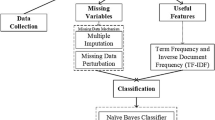Abstract
The increased propagation of fake news is the significant concern in the digital era. Identification of fake news from social media platforms is critical to strengthen public trust and ensure social stability. This research presents an effective and accurate framework for identifying fake news that combines different steps of natural language processing (NLP) technique along with a neural network architecture. A novel semantic veracity enhancement (SVE) classifier is designed and implemented in this work for detecting fake news. The proposed approach leverages the effectiveness of sentiment analysis for identifying misleading or deceptive content and its subsequent implications on the sentiment and behaviour of social media users. A BERT model is used in this research for analysing the sentiments and classifying the texts from the social media platform. By examining the sentiments, the SVE classifier differentiates between real news and fabricated content. To achieve this, three different datasets comprising both actual content and fabricated (tweaked) tweets are employed for training the SVE classifier. The potentiality of the SVE classifier is evaluated and compared with different optimization techniques. The outcome of the experimental analysis shows that the proposed approach exhibits an excellent performance in terms of classifying misinformation from the original information with an outstanding accuracy of 99% compared to other state of art methods.











Similar content being viewed by others
Data availability
Data and materials would be made available on request.
References
Al-Asadi MA, Tasdemir S (2022) Using artificial intelligence against the phenomenon of fake news: a systematic literature review. Combat Fake News Comput Intell Tech. https://doi.org/10.1007/978-3-030-90087-8_2
Alonso MA, Vilares D, Gómez-Rodríguez C, Vilares J (2021) Sentiment analysis for fake news detection. Electronics 10(11):1348. https://doi.org/10.3390/electronics10111348
Amira A, Derhab A, Hadjar S, Merazka M, Alam MGR, Hassan MM (2023) Detection and analysis of fake news users communities in social media. IEEE Trans Comput Soc Syst. https://doi.org/10.1109/TCSS.2023.3282572
Babar M, Ahmad A, Tariq MU, Kaleem S (2023) Real-time fake news detection using big data analytics and deep neural network. IEEE Trans Comput Soc Syst. https://doi.org/10.1109/TCSS.2023.3309704
Bello A, Ng SC, Leung MF (2023) A BERT framework to sentiment analysis of tweets. Sensors 23(1):506. https://doi.org/10.3390/s23010506
Bhowmik NR, Arifuzzaman M, Mondal MRH (2022) Sentiment analysis on Bangla text using extended lexicon dictionary and deep learning algorithms. Array 13:100123. https://doi.org/10.1016/j.array.2021.100123
Choudhary M, Jha S, Saxena D, Singh AK (2021) A review of fake news detection methods using machine learning. In: 2021 2nd international conference for emerging technology (INCET), pp. 1-5. IEEE, India. https://doi.org/10.1109/INCET51464.2021.9456299
Hamdi T, Slimi H, Bounhas I, Slimani Y (2020) A hybrid approach for fake news detection in twitter based on user features and graph embedding. In: distributed computing and internet technology: 16th international conference, ICDCIT 2020, Bhubaneswar, India, January 9–12, 2020, Proceedings, pp 266-280. Springer International Publishing, Heidelberg. https://doi.org/10.1007/978-3-030-36987-3_17
Hawashin B, Althunibat A, Kanan T, AlZu'bi S, Sharrab Y (2023) Improving arabic fake news detection using optimized feature selection. In: 2023 International Conference on Information Technology (ICIT), pp. 690-694. IEEE, Jordan. https://doi.org/10.1109/ICIT58056.2023.10225974
Kavitha R, Jothi DK, Saravanan K, Swain MP, Gonzáles JLA, Bhardwaj RJ, Adomako E (2023) Ant colony optimization-enabled CNN deep learning technique for accurate detection of cervical cancer. BioMed Res Int 2023:1742891. https://doi.org/10.1155/2023/1742891
Kesarwani A, Chauhan SS, Nair AR (2020) Fake news detection on social media using k-nearest neighbor classifier. In: 2020 international conference on advances in computing and communication engineering (ICACCE), pp. 1-4. IEEE, USA. https://doi.org/10.1109/ICACCE49060.2020.9154997
Kokab ST, Asghar S, Naz S (2022) Transformer-based deep learning models for the sentiment analysis of social media data. Array 14:100157. https://doi.org/10.1016/j.array.2022.100157
Kozik R, Pawlicka A, Pawlicki M, Choraś M, Mazurczyk W, Cabaj K (2023) A meta-analysis of state-of-the-art automated fake news detection methods. IEEE Trans Comput Soc Syst. https://doi.org/10.1109/TCSS.2023.3296627
Kula S, Choraś M, Kozik R (2021) Application of the BERT-based architecture in fake news detection. In: 13th international conference on computational intelligence in security for information systems (CISIS 2020), 1267. Springer, Cham
Mridha MF, Keya AJ, Hamid MA, Monowar MM, Rahman MS (2021) A comprehensive review on fake news detection with deep learning. IEEE Access 9:156151–156170. https://doi.org/10.1109/ACCESS.2021.3129329
Nasir JA, Khan OS, Varlamis I (2021) Fake news detection: a hybrid CNN-RNN based deep learning approach. Int J Inf Manage Data Insights 1(1):100007. https://doi.org/10.1016/j.jjimei.2020.100007
Pal A, Pradhan M (2023) Survey of fake news detection using machine intelligence approach. Data Knowl Eng 144:102118. https://doi.org/10.1016/j.datak.2022.102118
Patel A, Meehan K (2021) Fake news detection on reddit utilising Count Vectorizer and term frequency-inverse document frequency with logistic regression, MultinominalNB and support vector machine. In: 2021 32nd Irish signals and systems conference (ISSC), pp. 1-6. IEEE, Ireland. https://doi.org/10.1109/ISSC52156.2021.9467842
Pillai SEVS, Hu WC (2023) Misinformation detection using an ensemble method with emphasis on sentiment and emotional analyses. In: 2023 IEEE/ACIS 21st international conference on software engineering research, management and applications (SERA), pp. 295-300. IEEE, USA. https://doi.org/10.1109/SERA57763.2023.10197706
Prottasha NJ, Sami AA, Kowsher M, Murad SA, Bairagi AK, Masud M, Baz M (2022) Transfer learning for sentiment analysis using BERT based supervised fine-tuning. Sensors 22(11):4157. https://doi.org/10.3390/s22114157
Qi P, Bu Y, Cao J, Ji W, Shui R, Xiao J, Wang D, Chua TS (2023) FakeSV: A multimodal benchmark with rich social context for fake news detection on short video platforms. In: Proceedings of the AAAI Conference on Artificial Intelligence. vol 37, pp 14444-14452 (2023). https://doi.org/10.1609/aaai.v37i12.26689
Singhal S, Kabra A, Sharma M, Shah RR, Chakraborty T, Kumaraguru P (2020) Spotfake+: a multimodal framework for fake news detection via transfer learning (student abstract). In: Proceedings of the AAAI conference on artificial intelligence. vol 34(10), pp 13915–13916. https://doi.org/10.1609/aaai.v34i10.7230
Srinivas J, Venkata Subba Reddy K, Sunny Deol GJ, VaraPrasada Rao P (2021) Automatic fake news detector in social media using machine learning and natural language processing approaches. In: Smart computing techniques and applications: proceedings of the fourth international conference on smart computing and informatics. vol 2 pp 295–305. https://doi.org/10.1088/1757-899X/1099/1/012040
Vallileka N, Sundaravadivel P, Karthikeyan U, Krishnan RS, Narayanan KL, Sundararajan S (2023) DeepTweet: leveraging transformer-based models for enhanced fake news detection in twitter sentiment analysis. In: 2023 7th International Conference on I-SMAC (IoT in Social, Mobile, Analytics and Cloud) (I-SMAC), pp. 438-443. IEEE, Nepal. https://doi.org/10.1109/I-SMAC58438.2023.10290217
Vishwakarma DK, Meel P, Yadav A, Singh K (2023) A framework of fake news detection on web platform using ConvNet. Soc Netw Anal Min 13(1):24. https://doi.org/10.1007/s13278-023-01026-7
Vishwakarma DK, Jain C (2020) Recent state-of-the-art of fake news detection: a review. In: 2020 international conference for emerging technology (INCET), pp. 1-6. IEEE, India. https://doi.org/10.1109/INCET49848.2020.9153985
Wani A, Joshi I, Khandve S, Wagh V, Joshi R (2021) Evaluating deep learning approaches for covid19 fake news detection. In: Chakraborty T, Shu K, Bernard HR, Liu H, Akhtar MS (eds) Combating online hostile posts in regional languages during emergency situation. CONSTRAINT 2021. Communications in computer and information science, vol 1402. Springer, Cham. https://doi.org/10.1007/978-3-030-73696-5_15
Yadav A, Gaba S, Khan H, Budhiraja I, Singh A, Singh KK (2023) ETMA: efficient transformer-based multilevel attention framework for multimodal fake news detection. IEEE Trans Comput Soc Syst. https://doi.org/10.1109/TCSS.2023.3255242
Zervopoulos A, Alvanou AG, Bezas K, Papamichail A, Maragoudakis M, Kermanidis K (2022) Deep learning for fake news detection on twitter regarding the 2019 Hong Kong protests. Neural Comput Appl 34(2):969–982. https://doi.org/10.1007/s00521-021-06230-0
Zhou X, Zafarani R (2020) A survey of fake news: Fundamental theories, detection methods, and opportunities. ACM Comput Surv (CSUR) 53(5):1–40. https://doi.org/10.1145/3395046
Funding
No funding was received to assist with the preparation of this manuscript.
Author information
Authors and Affiliations
Contributions
MRS was involved in conceptualization, methodology, software, data curation, validation, writing—original draft, and writing—review and editing. NK was involved in visualization, investigation, supervision, validation, formal analysis, project administration, and resources.
Corresponding author
Ethics declarations
Conflict of interest
On behalf of all authors, the corresponding author states that there is no conflict of interest.
Consent to participate
No human subjects were involved in this study.
Consent for publication
No individual subjects or their data were involved in this research.
Additional information
Publisher's Note
Springer Nature remains neutral with regard to jurisdictional claims in published maps and institutional affiliations.
Rights and permissions
Springer Nature or its licensor (e.g. a society or other partner) holds exclusive rights to this article under a publishing agreement with the author(s) or other rightsholder(s); author self-archiving of the accepted manuscript version of this article is solely governed by the terms of such publishing agreement and applicable law.
About this article
Cite this article
Sethurajan, M.R., Natarajan, K. Performance analysis of semantic veracity enhance (SVE) classifier for fake news detection and demystifying the online user behaviour in social media using sentiment analysis. Soc. Netw. Anal. Min. 14, 36 (2024). https://doi.org/10.1007/s13278-024-01199-9
Received:
Revised:
Accepted:
Published:
DOI: https://doi.org/10.1007/s13278-024-01199-9




